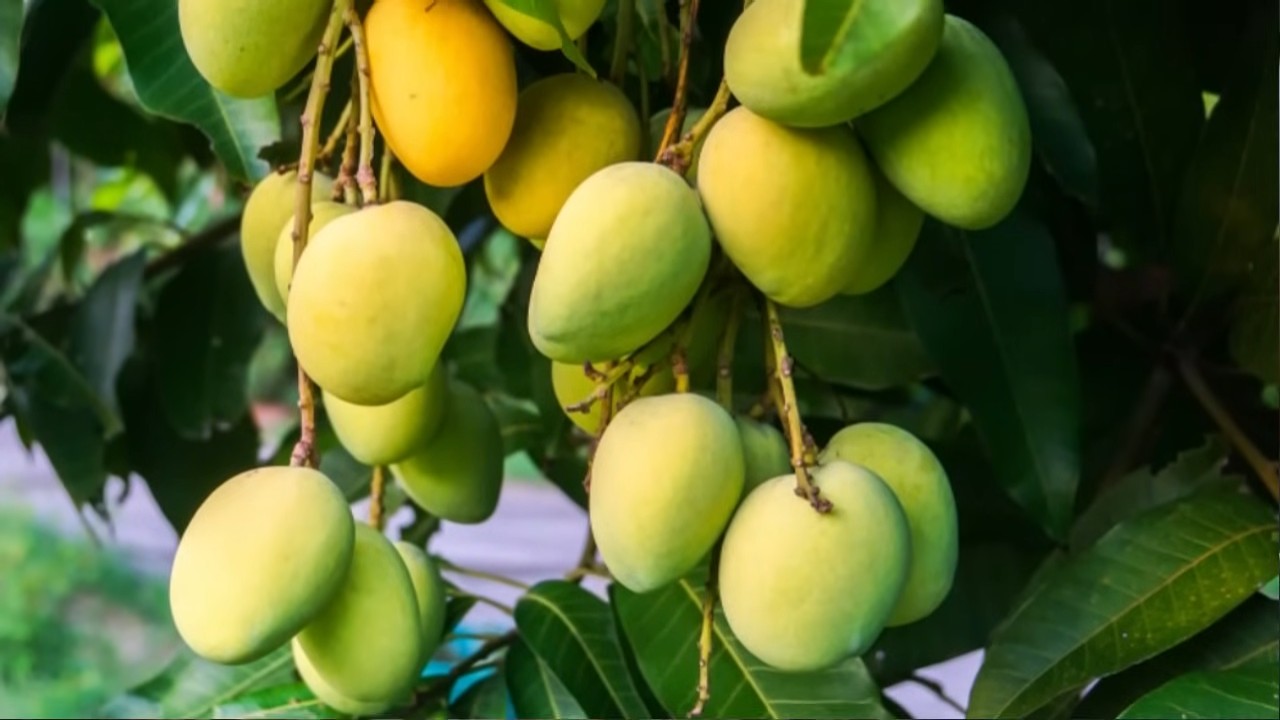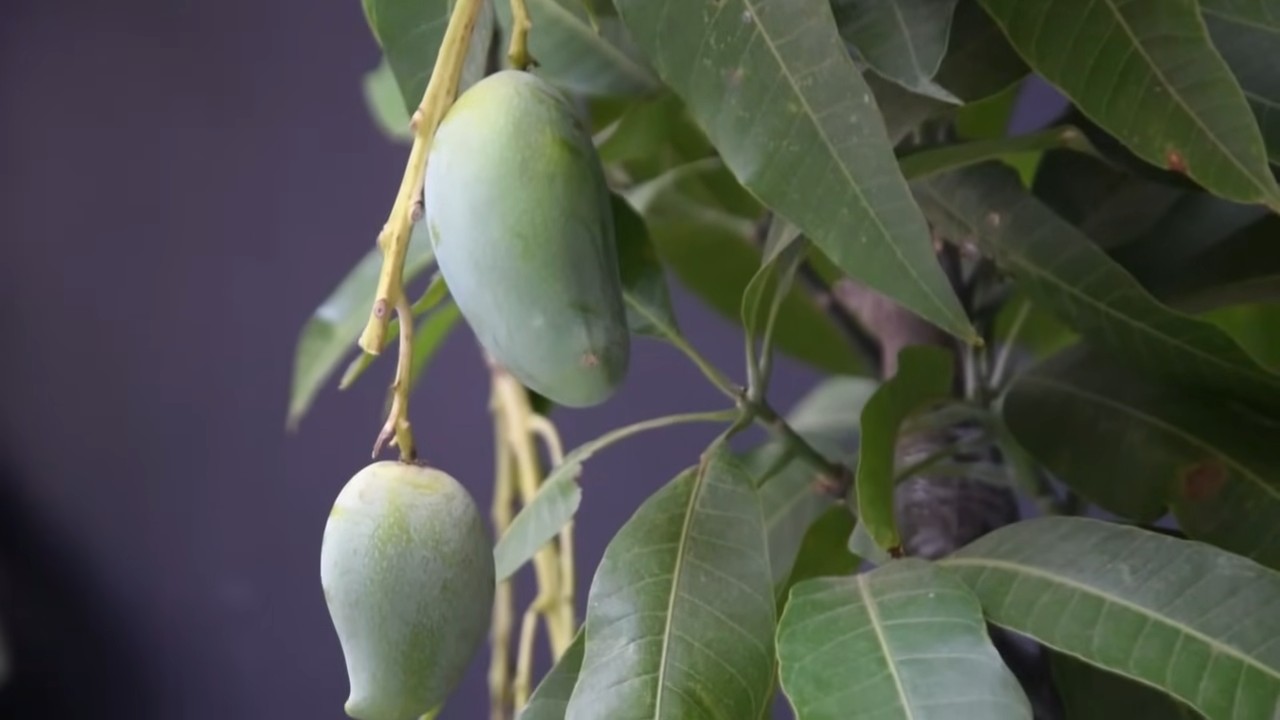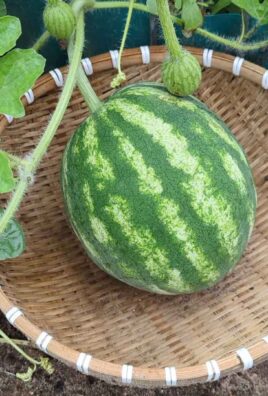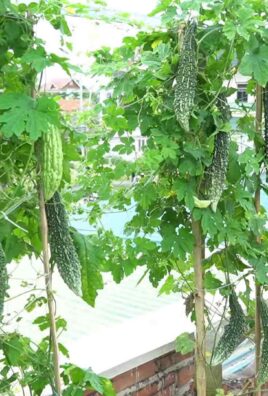Grow Mangoes at Home? Absolutely! Imagine stepping into your backyard and plucking a juicy, sun-ripened mango straight from your own tree. Sounds like a tropical dream, right? Well, it’s more attainable than you might think! This isn’t just about having fresh fruit; it’s about connecting with nature, enjoying the satisfaction of nurturing life, and adding a touch of the exotic to your everyday life.
Mangoes have a rich history, dating back thousands of years in India, where they’re considered a symbol of love and prosperity. Cultivating them has been a cherished tradition passed down through generations. While traditionally grown in tropical climates, innovative DIY techniques now make it possible to grow mangoes at home, even if you don’t live in the perfect environment.
In today’s fast-paced world, we often lose touch with the simple pleasures of growing our own food. This DIY guide is designed to empower you with the knowledge and skills to successfully cultivate your own mango tree. Whether you’re a seasoned gardener or a complete beginner, I’ll walk you through every step, from choosing the right variety to protecting your tree from pests and diseases. Get ready to embark on a rewarding journey and enjoy the sweet taste of success – literally!

Grow Your Own Delicious Mangoes: A DIY Guide
Okay, mango lovers, listen up! Have you ever dreamed of plucking a perfectly ripe, juicy mango straight from your own tree? Well, guess what? It’s totally achievable, even if you don’t live in a tropical paradise. I’m going to walk you through everything you need to know to grow your own mangoes at home. It might seem daunting at first, but trust me, with a little patience and the right know-how, you’ll be enjoying homegrown mangoes before you know it!
Choosing Your Mango Variety
First things first, you need to decide which mango variety you want to grow. This is a crucial step because not all mangoes are created equal, and some are better suited for container growing than others.
* Consider your climate: Some mango varieties are more cold-hardy than others. If you live in an area with cold winters, you’ll want to choose a variety that can tolerate cooler temperatures or be easily moved indoors.
* Think about size: Mango trees can get quite large, so if you’re planning on growing your mango in a container, you’ll want to choose a dwarf or semi-dwarf variety. These varieties are bred to stay smaller and more manageable.
* Flavor preferences: Of course, you’ll want to choose a variety that you actually enjoy eating! Do some research and find out which mangoes are known for their sweetness, tanginess, or other flavor characteristics.
Some popular dwarf and semi-dwarf mango varieties that are well-suited for container growing include:
* ‘Nam Doc Mai’: This Thai variety is known for its sweet, creamy flesh and relatively small size.
* ‘Cogshall’: A compact variety with vibrant red and yellow fruit. It’s known for its rich, sweet flavor.
* ‘Julie’: A very dwarf variety, perfect for smaller spaces. The fruit is sweet and slightly spicy.
* ‘Carrie’: A fiberless variety with a rich, sweet flavor. It’s relatively cold-hardy.
Once you’ve chosen your variety, you can purchase a grafted mango tree from a reputable nursery. Grafted trees are more likely to produce fruit sooner than trees grown from seed.
Getting Started: Planting Your Mango Tree
Now that you have your mango tree, it’s time to get it planted! Here’s what you’ll need:
* A well-draining container (at least 20 gallons for a dwarf variety, larger for others)
* High-quality potting mix (specifically formulated for fruit trees is ideal)
* A sunny location (mangoes need at least 6-8 hours of sunlight per day)
* Watering can or hose
* Fertilizer (specifically formulated for mangoes or fruit trees)
* Mulch (optional)
Step-by-Step Planting Instructions:
1. Choose the Right Container: Make sure your container has drainage holes! Mangoes hate sitting in soggy soil. A large container is essential to allow the roots to grow and thrive.
2. Prepare the Potting Mix: Fill the container about one-third full with your potting mix.
3. Remove the Mango Tree from its Nursery Pot: Gently loosen the roots of the mango tree. If the roots are circling the pot, gently tease them apart to encourage them to grow outwards.
4. Position the Tree: Place the mango tree in the center of the container, making sure the top of the root ball is level with the top of the potting mix.
5. Fill the Container: Fill the rest of the container with potting mix, gently patting it down around the root ball.
6. Water Thoroughly: Water the mango tree thoroughly until water drains out of the drainage holes. This will help settle the soil and ensure the roots are well-hydrated.
7. Add Mulch (Optional): Apply a layer of mulch around the base of the tree to help retain moisture and suppress weeds. Keep the mulch a few inches away from the trunk to prevent rot.
8. Find a Sunny Spot: Place your newly planted mango tree in a sunny location where it will receive at least 6-8 hours of direct sunlight per day.
Caring for Your Mango Tree: Watering, Fertilizing, and Pruning
Okay, your mango tree is planted, but the work doesn’t stop there! Here’s how to keep it happy and healthy:
Watering
* Water deeply but infrequently: Mangoes prefer to dry out slightly between waterings. Water deeply when the top inch or two of soil feels dry to the touch.
* Avoid overwatering: Overwatering can lead to root rot, which is a common problem for mango trees. Make sure your container has good drainage and avoid letting the tree sit in standing water.
* Adjust watering based on the season: During the growing season (spring and summer), you’ll need to water more frequently than during the dormant season (fall and winter).
Fertilizing
* Use a balanced fertilizer: Fertilize your mango tree with a balanced fertilizer specifically formulated for mangoes or fruit trees. Look for a fertilizer with a ratio of 6-6-6 or 8-3-9.
* Fertilize regularly during the growing season: Fertilize your mango tree every 4-6 weeks during the growing season (spring and summer).
* Reduce or stop fertilizing during the dormant season: During the dormant season (fall and winter), you can reduce or stop fertilizing altogether.
* Follow the instructions on the fertilizer label: Be sure to follow the instructions on the fertilizer label carefully to avoid over-fertilizing.
Pruning
* Prune to shape the tree: Prune your mango tree to shape it and encourage branching. Remove any dead, damaged, or crossing branches.
* Prune after fruiting: The best time to prune your mango tree is after it has finished fruiting.
* Remove suckers: Remove any suckers that grow from the base of the tree. These suckers will steal nutrients from the main tree.
* Don’t over-prune: Avoid over-pruning, as this can reduce fruit production.
Dealing with Pests and Diseases
Like all plants, mango trees can be susceptible to pests and diseases. Here are some common problems to watch out for:
* Mango Hoppers: These tiny insects suck sap from the leaves and flowers of mango trees. They can cause leaf drop and reduce fruit production. Treat with insecticidal soap or neem oil.
* Scales: These small, armored insects attach themselves to the leaves and stems of mango trees. They can cause yellowing and leaf drop. Treat with horticultural oil or insecticidal soap.
* Anthracnose: This fungal disease causes dark spots on the leaves, flowers, and fruit of mango trees. It can be especially problematic in humid climates. Treat with a fungicide.
* Powdery Mildew: This fungal disease causes a white, powdery coating on the leaves and stems of mango trees. Treat with a fungicide.
Prevention is key! Keep your mango tree healthy and strong by providing it with proper care. This will make it less susceptible to pests and diseases. Regularly inspect your tree for signs of problems and take action quickly if you notice anything unusual.
Encouraging Fruit Production
Getting your mango tree to actually produce fruit can be a bit of a challenge, especially in cooler climates. Here are some tips to encourage fruit production:
* Ensure adequate sunlight: Mangoes need at least 6-8 hours of sunlight per day to produce fruit.
* Provide proper watering and fertilization: A healthy tree is more likely to produce fruit.
* Protect from frost: Mangoes are sensitive to frost. If you live in an area with cold winters, you’ll need to protect your tree from frost by moving it indoors or covering it with a blanket.
* Hand-pollinate if necessary: Mangoes are typically pollinated by insects, but if you don’t have many insects in your area, you may need to hand-pollinate the flowers. Use a small paintbrush to transfer pollen from one flower to another.
* Be patient: Mango trees can take several years to start producing fruit. Don’t get discouraged if you don’t see fruit right away.
Harvesting Your Mangoes
Finally, the moment you’ve been waiting for! Harvesting your own homegrown mangoes!
* Look for signs of ripeness: Mangoes are typically ready to harvest when they change color from green to yellow or red. They should also be slightly soft to the touch.
* Gently twist the mango from the tree: When the mango is ripe, it should come off the tree easily with a gentle twist.
* Allow the mangoes to ripen further off the tree: Mangoes will continue to ripen after they’ve been harvested. Place them in a paper bag at room temperature to ripen.
* Enjoy your delicious

Conclusion
So, there you have it! Growing mangoes at home might seem like a tropical dream reserved for those with sprawling orchards, but with a little patience, the right techniques, and our simple DIY trick, you can absolutely cultivate these delicious fruits right in your own backyard or even in a container on your patio. This isn’t just about saving money on store-bought mangoes; it’s about the satisfaction of nurturing a plant from seed (or sapling) to fruit, connecting with nature, and enjoying the unparalleled flavor of a homegrown mango, ripened to perfection under your care.
Why is this DIY trick a must-try? Because it simplifies the process, increases your chances of success, and empowers you to take control of your mango-growing journey. We’ve demystified the complexities, providing you with a clear, step-by-step guide that anyone can follow, regardless of their gardening experience. Plus, imagine the bragging rights when you serve your friends and family a dessert featuring mangoes you grew yourself!
But don’t stop there! Experiment with different varieties of mangoes to find your favorite flavor profile. Try grafting different varieties onto a single rootstock for a diverse harvest. Consider using organic fertilizers and pest control methods to ensure the healthiest and most flavorful fruit. You can even explore different container sizes and soil mixes to optimize growth in your specific climate.
This is more than just a recipe for growing mangoes; it’s an invitation to embark on a rewarding horticultural adventure. We encourage you to try this DIY trick and witness the magic of transforming a simple seed or sapling into a thriving mango tree. And most importantly, share your experience with us! Let us know what worked for you, what challenges you faced, and any tips or variations you discovered along the way. Your feedback will not only help us improve this guide but also inspire other aspiring mango growers to take the plunge. Growing mangoes at home is a journey best shared, so let’s cultivate a community of passionate mango enthusiasts! We are confident that with our guide, you’ll be enjoying your own homegrown mangoes before you know it.
Frequently Asked Questions About Growing Mangoes at Home
What is the best time of year to plant a mango tree?
The ideal time to plant a mango tree is during the late spring or early summer, after the last frost has passed. This gives the tree ample time to establish its roots before the onset of winter. However, in warmer climates with mild winters, you can plant mango trees year-round, provided you protect them from extreme temperatures.
How long does it take for a mango tree to bear fruit?
The time it takes for a mango tree to bear fruit depends on several factors, including the variety of mango, the age of the tree, and the growing conditions. Seedling mango trees (grown from seed) can take anywhere from 5 to 8 years to produce fruit. Grafted mango trees, on the other hand, typically bear fruit within 3 to 5 years. Providing optimal growing conditions, such as plenty of sunlight, well-draining soil, and regular fertilization, can help accelerate the fruiting process.
What kind of soil is best for mango trees?
Mango trees thrive in well-draining soil that is rich in organic matter. The ideal soil pH is between 6.0 and 7.5. Avoid planting mango trees in heavy clay soil, as this can lead to root rot. If your soil is not ideal, you can amend it with compost, peat moss, or other organic materials to improve drainage and fertility.
How much sunlight do mango trees need?
Mango trees require at least 6 to 8 hours of direct sunlight per day to thrive and produce fruit. Choose a planting location that receives plenty of sunlight throughout the day. If you are growing mango trees in containers, you can move them to a sunnier location as needed.
How often should I water my mango tree?
Water your mango tree deeply and regularly, especially during the first few years after planting. Allow the soil to dry out slightly between waterings to prevent root rot. During the dry season, you may need to water your mango tree more frequently. Once the tree is established, it will be more drought-tolerant.
What are some common pests and diseases that affect mango trees?
Mango trees can be susceptible to a variety of pests and diseases, including mango hoppers, fruit flies, scales, anthracnose, and powdery mildew. Regularly inspect your tree for signs of pests or diseases and take appropriate action to control them. Organic pest control methods, such as neem oil and insecticidal soap, can be effective for managing many common pests. Fungicides can be used to control fungal diseases.
Can I grow a mango tree in a container?
Yes, you can grow a mango tree in a container, especially if you live in a climate with cold winters. Choose a large container with drainage holes and use a well-draining potting mix. Dwarf mango varieties are best suited for container growing. Be sure to provide your container-grown mango tree with plenty of sunlight, water, and fertilizer. You may need to repot the tree every few years as it grows.
How do I fertilize my mango tree?
Fertilize your mango tree regularly with a balanced fertilizer that is specifically formulated for fruit trees. Apply fertilizer in the spring and summer, following the instructions on the fertilizer label. Avoid fertilizing in the fall or winter, as this can encourage new growth that is susceptible to frost damage.
How do I prune my mango tree?
Pruning is essential for maintaining the shape and health of your mango tree. Prune your tree in the late winter or early spring, before new growth begins. Remove any dead, damaged, or diseased branches. You can also prune to shape the tree and improve air circulation.
How do I protect my mango tree from frost?
Mango trees are sensitive to frost and can be damaged by freezing temperatures. If you live in an area with occasional frosts, you will need to protect your tree during the winter months. You can wrap the trunk of the tree with burlap or blankets to insulate it. You can also cover the entire tree with a frost cloth. For container-grown mango trees, you can move them indoors to a protected location.
What are some popular varieties of mangoes to grow at home?
There are many different varieties of mangoes to choose from, each with its own unique flavor and characteristics. Some popular varieties for home growing include Tommy Atkins, Haden, Kent, Keitt, and Alphonso. Research different varieties to find one that is well-suited to your climate and personal preferences.
How do I know when a mango is ripe?
The color of a mango is not always an indicator of ripeness. To determine if a mango is ripe, gently squeeze it. A ripe mango will yield slightly to pressure. You can also smell the mango near the stem end. A ripe mango will have a sweet, fruity aroma.
Can I grow a mango tree from a store-bought mango seed?
Yes, you can grow a mango tree from a store-bought mango seed, but keep in mind that the resulting tree may not produce fruit that is identical to the parent mango. This is because mangoes are often hybrids. However, it can still be a fun and rewarding experience to grow a mango tree from seed.
What if my mango tree is not fruiting?
There are several reasons why your mango tree may not be fruiting. It could be too young, not receiving enough sunlight, not being properly fertilized, or experiencing stress from pests or diseases. Make sure your tree is receiving optimal growing conditions and address any potential problems. Patience is also key, as it can take several years for a mango tree to mature and begin producing fruit.





Leave a Comment